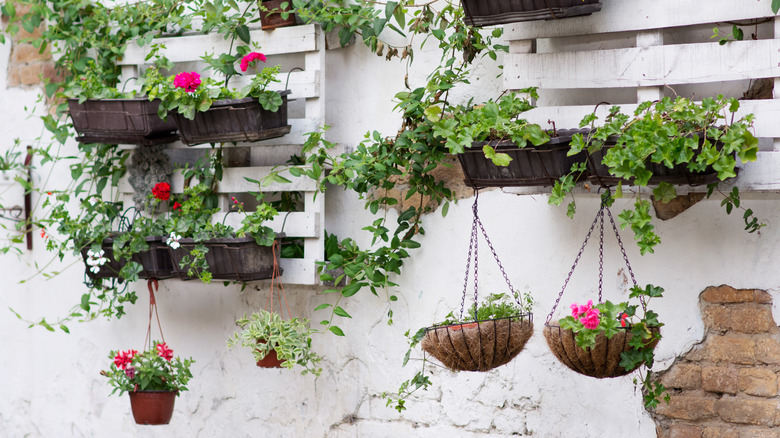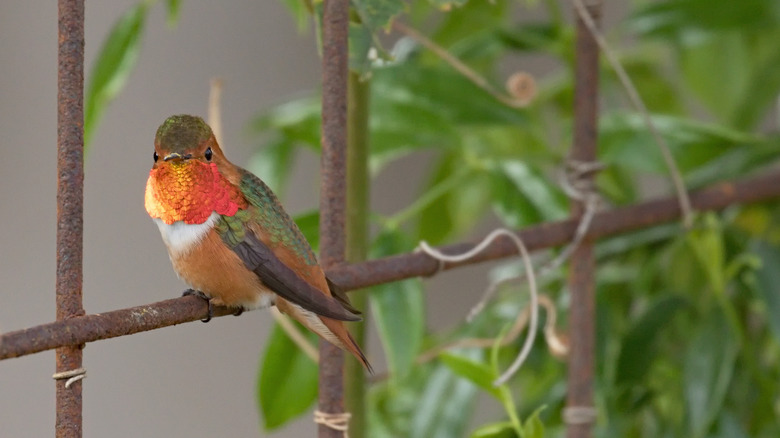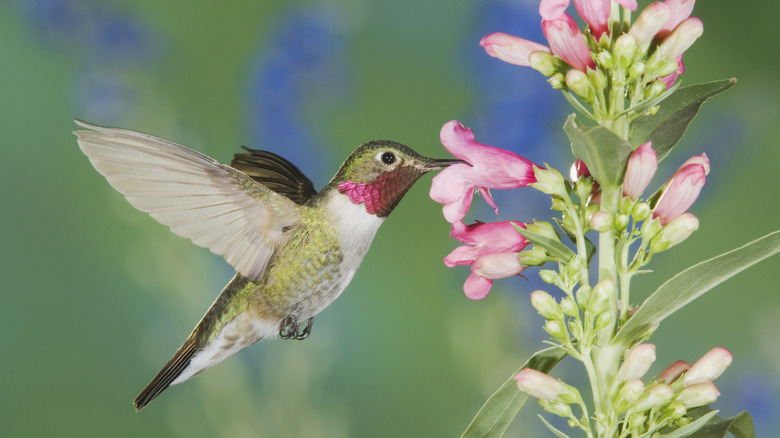A Vertical Garden Is The Key To Bringing In More Hummingbirds
Good designers keep their clients' needs in mind. But when your clients are hummingbirds, that can be challenging. These avian aerialists can zoom up and down, zip backward and forward, and even fly upside down. Unless you have a personal jet pack, you probably don't move around your home quite the same way. (But if you did, imagine how much easier it would be to clean your ceiling fan.) As humans, we navigate space horizontally, and we don't always think to look up. But to design for hummingbirds, you need to think vertically.
If hummingbirds are steering clear of your yard even though you put out feeders, they may be looking for more amenities. Hummingbirds naturally flock to areas with vertical layers of trees, shrubs, vines, and other plants. These stratified habitats provide a variety of feeding, perching, and nesting sites. But you don't need to convert your yard into a forest or jungle to make hummers feel at home. With a combination of trellises and containers — like window boxes, hanging baskets, and pots — you can effectively recreate these vertical layers in your garden. Of course, you can also grow hummingbird-friendly plants in the ground, but planting in containers allows you to renovate on the fly. By moving plants around, you can see what works best for your high-octane clients.
Tips for creating a vertical hummingbird garden
When it comes to designing hummer homes, location matters. Look for a quiet spot with a balance of shade and sun. Next, visualize how you can fill the space with plants at different levels. It might help to sketch your plans. Trellises and hanging baskets are great for adding height. Use window boxes and raised planters to fill in the middle zone and large pots or mixed containers for the ground level. Hummingbirds are territorial, so placing groups of pots and planters in multiple areas of your yard or patio will minimize skirmishes.
Hummingbird gardens are often eclectic, so get creative and think outside the (window) box. Look for materials you already have around the house. You can transform plain cinder blocks into a vertical garden by stacking them to create different layers and terraces. Similarly, you can add height by fastening pots to wooden pallets and mounting them on fences or walls. Instead of buying a trellis, look for ways to repurpose other items. Old window frames, doors, bicycle wheels, ladders, headboards, shutters, gates, and sections of old fencing can be used to train vines. Don't forget to leave room for feeders to sustain hungry hummers when fewer flowers are available. These nimble navigators also need places to rest and survey their territory, so include perches or swings. Everyone loves a water feature, and hummers are no exception. Misters and drip fountains make the best baths for these bitty birds.
Hummingbird-friendly plants for your vertical garden
Don't be afraid to go bold with your flower choices. Hummingbirds love a pop of color. But stick with native plants whenever possible and look for flowers with different blooming times so hummers have a steady nectar supply. You can find regional lists of native plants and their blooming cycles at Pollinator Partnership. Many native flowers, like Penstemons (such as beardtongues), Heucheras (coral bells), Monardas (bee balms), and Salvias (sages) grow well in pots, either individually or mixed with other species. Creeping phlox (Phlox stolonifera) looks lovely cascading out of hanging baskets or window boxes, as does rose verbena (Verbena canadensis). Trumpet vines (Campsis radicans) grow well on trellises and can be planted in large containers to prevent spreading. Honeysuckle (Lonicera sempervirens and Lonicera ciliosa) and crossvine (Bignonia capreolata) are other blooming vines hummingbirds can't resist.
Textures make homes feel cozy, and hummers especially like fuzzy and woolly fibers they can use to line their nests. Cinnamon fern (Osmundastrum cinnamomeum) produces fronds covered in dense wool, and it grows well in container gardens. Many native thistles like cobweb thistle (Cirsium occidentale) also have fuzzy fibers. American pussy willow (Salix discolor), blanket flowers (Gaillardia species), and native Clematis vines are other options. If you keep hummingbirds' vertical needs in mind, designing for them isn't as challenging as it seems. Maybe one day jet packs will offer a hummingbird's-eye view of the world, but for now, you'll have to haul out the ladder to dust those fan blades.



